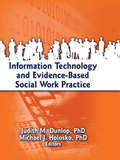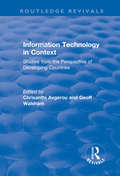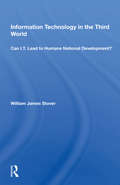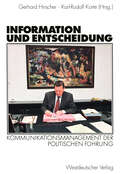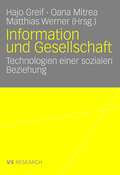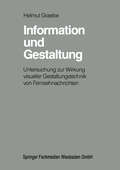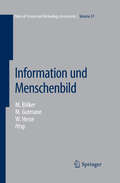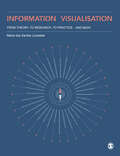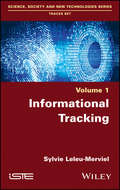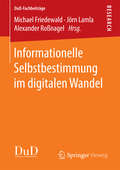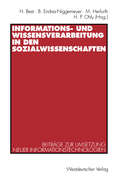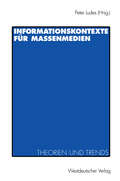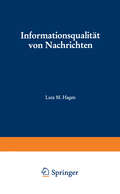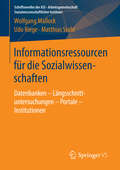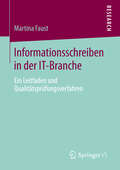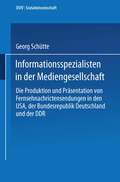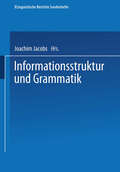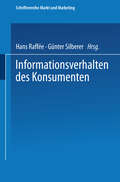- Table View
- List View
Information Technology and Evidence-Based Social Work Practice
by Judith M. Dunlop Michael J. HoloskoLearn to use the latest technological advances in evidence-based social workSocial work practice can be positively or negatively impacted by the advance of technology. Advances and applications must be up-to-date as possible, yet they may be ineffective if not simple enough to easily learn and use. Information Technology and Evidence-Based Social Work presents leading social work experts exploring the latest technological advances and the innovative practical applications which can be used effectively in evidence-based social work. Students and practitioners get creative practical advice on how best understand technology and apply it to their work.Information Technology and Evidence-Based Social Work is divided into four sections. The first section provides the context for understanding the technological link between social work and evidence-based practice. The second section presents examples of how information technology can be used to effectively teach students and practitioners in the field. Section three explores ways to implement technology for use by clients. The fourth section summarizes and then takes a look at the future of technology in evidence-based social work. Chapters include questions for practitioners and for clients to illuminate the current and future issues surrounding technology and evidence-based practice. The text also includes extensive references, and useful tables and figures.Topics in Information Technology and Evidence-Based Social Work include: the impact of technology on social work computer-assisted evidence-based practice customized web-based technology and its use in clinical supervision enhanced technology-based evidence-based practice model and its applicability to large human service organizations. using information technology to provide evidence for planning and evaluating programs using technology in advocacy the geographic information system (GIS) as a useful tool in all aspects of programs and policies evaluating practice through information technology the development and evaluation of an online social work service psychotherapeutic group intervention for family caregivers over the Internet support group online chat a case study of how Internet chat group technology can be implemented with cancer survivors technology as a service learning mechanism for promoting positive youth development in a community-based setting a model which can be used to collect information and—by using best evidence available—arrive at a confident decision and more! Information Technology and Evidence-Based Social Work is timely, stimulating reading for educators, undergraduate students, graduate students, and practitioners in the fields of social work, psychology, and public administration.
Information Technology in Context: Studies from the Perspective of Developing Countries (Routledge Revivals)
by Chrisanthi Avgerou Geoff WalshamThis title was first published in 2000. A discussion of information technology (IT) in developing countries. The contributors can be considered to share the following set of broad premises: information and communication technologies, and related systems, have significant potential to aid the economic growth and improvement of social conditions in the developing world; however, such potential is not released by simply transferring technologies and processes from advanced economies; in order to better serve development needs, people involved with the design, implementation and management of IT-related projects and systems in developing countries must improve their capacity to address the specific contextual characteristics of the organization, sector, country or region within which their work is located. The text thus emphasizes the importance of context in examining the role and value of IT in the developing countries. It focuses attention on the fusion of the activities of "professionals" (technical experts, managers, policy makers) and "users" (more broadly, all other groups affecting or affected by the technologies and systems), with the intention of facilitating locally meaningful and effective change.
Information Technology in Context: Studies from the Perspective of Developing Countries (Routledge Revivals)
by Chrisanthi Avgerou Geoff WalshamThis title was first published in 2000. A discussion of information technology (IT) in developing countries. The contributors can be considered to share the following set of broad premises: information and communication technologies, and related systems, have significant potential to aid the economic growth and improvement of social conditions in the developing world; however, such potential is not released by simply transferring technologies and processes from advanced economies; in order to better serve development needs, people involved with the design, implementation and management of IT-related projects and systems in developing countries must improve their capacity to address the specific contextual characteristics of the organization, sector, country or region within which their work is located. The text thus emphasizes the importance of context in examining the role and value of IT in the developing countries. It focuses attention on the fusion of the activities of "professionals" (technical experts, managers, policy makers) and "users" (more broadly, all other groups affecting or affected by the technologies and systems), with the intention of facilitating locally meaningful and effective change.
Information Technology In The Third World: Can I.T. Lead To Humane National Development?
by William James StoverMass media, telecommunications, and computer technology can effect change in poor countries, but Third World leaders are often disappointed in the results. Professor Stover looks closely at information technology and communication as agents of economic, social, and political development in Third World countries, stressing that definitions of "communication" and "development" must include participation in the exchange of information and the attainment of humane values. He examines reasons why the current world information order does not meet the needs of the Third World and argues that the major difficulty in achieving the potential of information technology for humane development is a cyclical pattern involving technology and values. When countries acquire the physical means of communication, their leaders are tempted to control them, resulting in censorship that prevents genuine communication. Breaking this cycle is a major requirement in using information technology for development, and Dr. Stover discusses how this may be accomplished practically in developmental, Western, and Soviet contexts.
Information Technology In The Third World: Can I.T. Lead To Humane National Development?
by William James StoverMass media, telecommunications, and computer technology can effect change in poor countries, but Third World leaders are often disappointed in the results. Professor Stover looks closely at information technology and communication as agents of economic, social, and political development in Third World countries, stressing that definitions of "communication" and "development" must include participation in the exchange of information and the attainment of humane values. He examines reasons why the current world information order does not meet the needs of the Third World and argues that the major difficulty in achieving the potential of information technology for humane development is a cyclical pattern involving technology and values. When countries acquire the physical means of communication, their leaders are tempted to control them, resulting in censorship that prevents genuine communication. Breaking this cycle is a major requirement in using information technology for development, and Dr. Stover discusses how this may be accomplished practically in developmental, Western, and Soviet contexts.
Information und Entscheidung: Kommunikationsmanagement der politischen Führung
by Gerhard Hirscher Karl-Rudolf KorteWas der Fernsehzuschauer in den Nachrichten sieht, ist das Endstück einer langen Entscheidungskette. Bevor Informationen der politischen Führung öffentlich werden, bahnen sie sich ihren langen Weg. Doch wie funktioniert das? Was ist die Entscheidungsgrundlage dabei? Welchen Einfluss haben persönliche oder administrative Faktoren? In diesem Buch werden die kommunikativen Organisationsabläufe beim politischen Spitzenpersonal und in den Parteien untersucht. Es werden die formellen und informellen Strukturen der Informationsabläufe bei Spitzenpolitikern, in den Parteizentralen und in den Fraktionen dargestellt. Damit kann erstmals der Versuch einer systematischen Analyse des politischen Kommunikationsmanagements in Bund, Land und im internationalen Vergleich vorgelegt werden.
Information und Gesellschaft: Technologien einer sozialen Beziehung
by Hajo Greif Oana Mitrea Matthias WernerInformations- und Kommunikationstechnologien sind nicht nur ein fester Bestandteil der täglichen Lebens- und Arbeitswelt, sondern strukturieren auch den Weltzugang gesellschaftlicher Akteure. Der Band versammelt Beiträge aus den Technik- und Sozialwissenschaften zur Beziehung zwischen Information und Gesellschaft.
Information und Gestaltung: Untersuchung zur Wirkung visueller Gestaltungstechnik von Fernsehnachrichten
by Helmut GraebeInformation und Menschenbild (Ethics of Science and Technology Assessment #37)
by Michael Bölker Mathias Gutmann Wolfgang HesseBegriffe wie „Information" oder „Gen" beeinflussen den Wandel von Menschenbildern in Wissenschaft und Gesellschaft. Um zu einem angemessenen Verständnis vom Menschen zu gelangen, müssen die in die Forschung eingebrachten anthropologischen Prämissen kritisch analysiert werden. Der Band dokumentiert die Beiträge von Wissenschaftlern aus den Bereichen Informatik, Biologie und Philosophie zu einer Tagung, die sich mit der Bedeutung von Begriffen befasste, die vor allem in der neuesten biologisch-genetischen Forschung verwendet werden.
Information Visualisation: From Theory, To Research, To Practice and Back
by Maria dos Santos LonsdaleIn a world of information overload, this book will help you to cut through the noise and communicate information with clear, efficient, and engaging visualisations. Taking you on a journey through a full range of different types of visualisations including infographics and motion graphics, the book: • Explains the underlying principles behind information visualisation, including the science of visual perception and cognition • Provides easy-to-digest guidelines that bring research and best practice together • Showcases a range of real-world applied examples, and outlines the do’s and don’ts of different approaches • Shows how to use research methods to design with and for your target audience. From an expert with years of experience researching, teaching, and doing information visualisation, learn how to make better and informed decisions around visualisation design that are appropriate for both your data and audience.
Information Visualisation: From Theory, To Research, To Practice and Back
by Maria dos Santos LonsdaleIn a world of information overload, this book will help you to cut through the noise and communicate information with clear, efficient, and engaging visualisations. Taking you on a journey through a full range of different types of visualisations including infographics and motion graphics, the book: • Explains the underlying principles behind information visualisation, including the science of visual perception and cognition • Provides easy-to-digest guidelines that bring research and best practice together • Showcases a range of real-world applied examples, and outlines the do’s and don’ts of different approaches • Shows how to use research methods to design with and for your target audience. From an expert with years of experience researching, teaching, and doing information visualisation, learn how to make better and informed decisions around visualisation design that are appropriate for both your data and audience.
Information Visualisation: From Theory, To Research, To Practice and Back
by Maria dos Santos LonsdaleIn a world of information overload, this book will help you to cut through the noise and communicate information with clear, efficient, and engaging visualisations. Taking you on a journey through a full range of different types of visualisations including infographics and motion graphics, the book: • Explains the underlying principles behind information visualisation, including the science of visual perception and cognition • Provides easy-to-digest guidelines that bring research and best practice together • Showcases a range of real-world applied examples, and outlines the do’s and don’ts of different approaches • Shows how to use research methods to design with and for your target audience. From an expert with years of experience researching, teaching, and doing information visualisation, learn how to make better and informed decisions around visualisation design that are appropriate for both your data and audience.
Informational Tracking
by Sylvie Leleu-Merviel“What is colour?”, “What is the precise meaning of the statement ‘the stock exchange closes at a 5% drop this evening’?”, “How are TV viewers defined?”, or “How can images produce meaning?” Such everyday questions are examined in this book. To make our analysis intuitive and understandable, numerous concrete examples illustrate our theoretical framework and concepts. The examples include gaming, fictional skits in leisure entertainment, and enigmas. The golden thread running through the text revisits the informational process and places the datum as its pivot. The epistemological perspective of our novel approach is that of “radical relativity”. This is based on the precept that a perceptual trace carries with it the spectrum of the process that has engendered it. Given this, the informational tracking endeavour tracks the meaning-making process, notably through interpretive scaffoldings that leads to plausible realities.
Informational Tracking
by Sylvie Leleu-Merviel“What is colour?”, “What is the precise meaning of the statement ‘the stock exchange closes at a 5% drop this evening’?”, “How are TV viewers defined?”, or “How can images produce meaning?” Such everyday questions are examined in this book. To make our analysis intuitive and understandable, numerous concrete examples illustrate our theoretical framework and concepts. The examples include gaming, fictional skits in leisure entertainment, and enigmas. The golden thread running through the text revisits the informational process and places the datum as its pivot. The epistemological perspective of our novel approach is that of “radical relativity”. This is based on the precept that a perceptual trace carries with it the spectrum of the process that has engendered it. Given this, the informational tracking endeavour tracks the meaning-making process, notably through interpretive scaffoldings that leads to plausible realities.
Informationelle Selbstbestimmung im digitalen Wandel (DuD-Fachbeiträge)
by Michael Friedewald Jörn Lamla Alexander RoßnagelDie Autoren des Buches untersuchen die historische und sachliche Bedingtheit des Konzepts der informationellen Selbstbestimmung, das zum Zweck des Persönlichkeitsschutzes in der modernen Datenverarbeitung zu einer Zeit und für Umstände entwickelt wurde, die inzwischen längst überholt sind. Thematisiert werden seine auch in absehbarer Zukunft erhaltenswerten Kernaussagen sowie die Änderungen, die in seinem Verständnis und seinen Umsetzungen notwendig sind, um die Ziele der informationellen Selbstbestimmung in einer veränderten digitalen Welt zu erreichen.
Informations- und Wissensverarbeitung in den Sozialwissenschaften: Beiträge zur Umsetzung neuer Informationstechnologien
by Heinrich Best Brigitte Endres-Niggemeyer Matthias Herfurth H. Peter OhlyDie Beiträge behandeln aus verschiedenen Blickwinkeln einen durch die Begriffe Sozialwissenschaft-Informatik-Information abgegrenzten, interdisziplinären Themenkomplex. Gerade in den Sozialwissenschaften haben die qualitative Textinterpretation und die Suche nach typischen, einzelnen Fällen ihren festen Stellenwert, und automatische Informationssuche und Informationsaufbereitung sind zu unverzichtbaren Forschungsinstrumenten geworden. Dieser Band enthält eine Vielzahl von Fachbeiträgen, die im Rahmen entsprechender Spezialveranstaltungen entstanden sind oder eigens für diesen Band geschrieben wurden. Sowohl als Einführungen wie auch im Rahmen spezieller Fragestellungen werden Ansätze aus den Gebieten künstliche Intelligenz, Bilderkennung, Kommunikationsnetze, Hypertext, Szientometrie, Bibliometrie u. a., jeweils mit Bezug auf sozialwissenschaftliche Anwendung, vorgestellt.
Informationskontexte für Massenmedien: Theorien und Trends
by Peter LudesVor dem Hintergrund aktueller übernationaler Medienentwicklungen konzentrieren sich die Beiträge dieses Bandes auf die wechselseitigen Abhängigkeiten und Ergänzungen von Medientexten und Informationskontexten. Die Autoren diskutieren im einzelnen: die technischen und rechtlichen Rahmenbedingungen, die Besonderheiten der Rezeption und ihres Einflusses auf die Informationsverarbeitung und das Gratifikationsinteresse von Fernsehzuschauern, die Entwicklungen von Fernsehinformationen im europäischen und asiatischen Raum sowie die Bedeutung von Fernsehinformationssendungen in Kriegs- und Krisenzeiten.
Informationsqualität von Nachrichten: Meßmethoden und ihre Anwendung auf die Dienste von Nachrichtenagenturen (Studien zur Kommunikationswissenschaft #6)
by Lutz M. HagenMit der politischen Bedeutsamkeit der Massenmedien wächst die Kritik an der Berichterstattung. In der Kommunikationswissenschaft äußert sich dies im Entstehen einer Qualitätsforschung, wobei die empirische Messung der Informationsqualität von Nachrichten im Mittelpunkt steht. Die Arbeit verdichtet zunächst medienrechtliche und journalistisch-professionelle Normen zu einem Katalog von Qualitätskriterien: Menge, Relevanz, Objektivität, Aktualität und Verständlichkeit von Information sind Gegenstand vieler empirischer Nachrichtenstudien, deren Methodenarsenal hier systematisiert, kritisiert und ergänzt wird. Es fließen kognitionspsychologische, textlinguistische und wissenschaftstheoretische Überlegungen ein. Ein neues, von Früh entwickeltes Verfahren wird adaptiert: die computergestützte Semantische Struktur- und Inhaltsanalyse (SSI). Die erarbeiteten Qualitätsindikatoren dienen einer quantitativen und qualitativen Analyse der universellen deutschen Agenturdienste. Deren Qualität ist von großem Interesse, denn Agenturen determinieren sehr stark die Nachrichteninhalte der Massenmedien.
Informationsressourcen für die Sozialwissenschaften: Datenbanken – Längsschnittuntersuchungen – Portale – Institutionen (Schriftenreihe der ASI - Arbeitsgemeinschaft Sozialwissenschaftlicher Institute)
by Wolfgang Mallock Udo Riege Matthias StahlDas Buch gibt einen strukturierten Überblick über ca. 360 Informationsressourcen für die Sozialwissenschaften. Beschrieben werden relevante Fachportale, Längsschnittuntersuchungen und Datenbanken. Die strukturierten Beschreibungen beinhalten u.a. eine kurze Selbstdarstellung, Informationen über Zugangsmöglichkeiten und –bedingungen sowie eine Fachgebietszuordnung. Ergänzt wird die Zusammenstellung durch eine Übersicht über relevante Institutionen, Forschungseinrichtungen, Forschungsdatenzentren und überregionale Informationsanbieter. Ein Fachgebietsregister erschließt alle Informationsressourcen.
Informationsschreiben in der IT-Branche: Ein Leitfaden und Qualitätsprüfungsverfahren
by Martina FaustDie Arbeit bietet dem Leser eine empirische Untersuchung mit hohem Erkenntniswert. Sie setzt in an beobachteten Schwächen der kommunikativen Praxis zwischen dem IT-Bereich und dem Bankwesen an und versucht die diagnostizierten Defizite auf der Basis der aktuellen Forschungsliteratur in einer Studie präziser zu erfassen und durch eine Expertise so weit wie möglich zu verringern. Es gilt, ein Optimierungsverfahren zu finden, das einen Weg ermöglicht, dass fachliche Informationsschreiben von Autoren aus diversen Bereichen eines IT-Unternehmens einheitlich und optimal verfasst und als Folge in den Banken von Empfängern in diversen Bereichen verstanden werden.
Informationsspezialisten in der Mediengesellschaft: Die Produktion und Präsentation von Fernsehnachrichtensendungen in den USA, der Bundesrepublik Deutschland und der DDR (DUV Sozialwissenschaft)
by Georg SchütteInformationsströme in digitalen Kulturen: Theoriebildung, Geschichte und logistischer Kapitalismus (Digitale Gesellschaft #57)
by Mathias DeneckeWir sind umgeben von einer Vielzahl an Informationsströmen, die uns selbstverständlich erscheinen. Um diese digitalen Kulturen zu beschreiben, entwickeln medienwissenschaftliche Arbeiten Theorien einer Welt im Fluss. Dabei erliegen ihre Diagnosen oftmals einem Technikfetisch und vernachlässigen gesellschaftliche Strukturen. Mathias Denecke legt eine systematische Kritik dieser Theoriebildung vor. Dazu zeichnet er die Geschichte der Rede von strömenden Informationen in der Entwicklung digitaler Computer nach und diskutiert, wie der Begriff für Gegenwartsbeschreibungen produktiv gemacht werden kann.
Informationsströme in digitalen Kulturen: Theoriebildung, Geschichte und logistischer Kapitalismus (Digitale Gesellschaft #57)
by Mathias DeneckeWir sind umgeben von einer Vielzahl an Informationsströmen, die uns selbstverständlich erscheinen. Um diese digitalen Kulturen zu beschreiben, entwickeln medienwissenschaftliche Arbeiten Theorien einer Welt im Fluss. Dabei erliegen ihre Diagnosen oftmals einem Technikfetisch und vernachlässigen gesellschaftliche Strukturen. Mathias Denecke legt eine systematische Kritik dieser Theoriebildung vor. Dazu zeichnet er die Geschichte der Rede von strömenden Informationen in der Entwicklung digitaler Computer nach und diskutiert, wie der Begriff für Gegenwartsbeschreibungen produktiv gemacht werden kann.
Informationsstruktur und Grammatik (Linguistische Berichte Sonderhefte #4)
by Joachim JacobsDas Sonderheft gibt einen Einblick in die aktuelle Forschung zur Informationsstruktur, d. h. zur Fokus-Hintergrund-Gliederung (FGH) und zur Topik-Prädikations-Gliederung (TPG). Das Hauptaugenmerk gilt der Rolle dieser Strukturierungsdimensionen in der Grammatik und in angrenzenden Bereichen der Pragmatik. Es werden neuere Ergebnisse zum Einfluß von FGH und TPG auf die syntaktische und phonologische Form sowie auf Wahrheits- und Verwendungsbedingungen präsentiert, um in Ausschnitten zu dokumentieren, welchen Stellenwert FGH und TPG im Rahmen des aktuellen Versuchs haben, einzelsprachliche Beschreibungen auf das Fundament universeller Theorien zu stellen und syntaktische und satzphonologische Analysen systematisch mit expliziten Bedeutungsanalysen zu verknüpfen.
